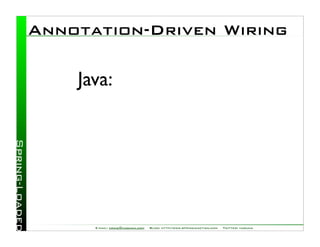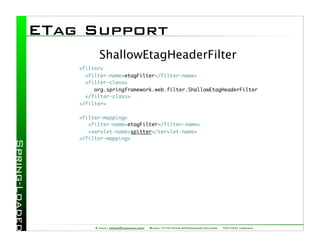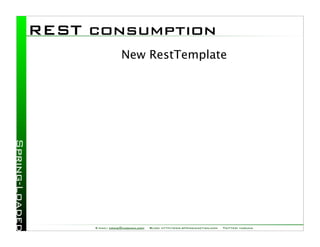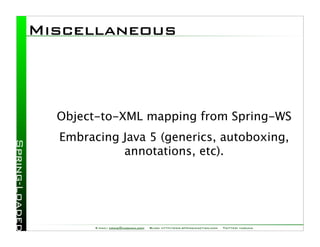Ad
What's new in Spring 3?
- 1. What’s New in Spring 3
- 2. Who Am I? E-mail: [email protected] Blog: http://www.springinaction.com Twitter: habuma
- 3. Who Am I? Java, Spring, and OSGi fanatic E-mail: [email protected] Blog: http://www.springinaction.com Twitter: habuma
- 4. Who Am I? Java, Spring, and OSGi fanatic Principal Consultant with Improving E-mail: [email protected] Blog: http://www.springinaction.com Twitter: habuma
- 5. Who Am I? Java, Spring, and OSGi fanatic Principal Consultant with Improving Author XDoclet in Action (Manning) Spring in Action (Manning) Modular Java (Pragmatic Bookshelf) E-mail: [email protected] Blog: http://www.springinaction.com Twitter: habuma
- 6. Who Am I? Java, Spring, and OSGi fanatic Principal Consultant with Improving Author XDoclet in Action (Manning) Spring in Action (Manning) Modular Java (Pragmatic Bookshelf) E-mail: [email protected] Blog: http://www.springinaction.com Twitter: habuma
- 7. Where we’ve been Spring: This is your life!
- 8. Evolution of Spring E-mail: [email protected] Blog: http://www.springinaction.com Twitter: habuma
- 9. Evolution of Spring Spring 1.x <bean class="..."> </bean> E-mail: [email protected] Blog: http://www.springinaction.com Twitter: habuma
- 10. Evolution of Spring Spring 1.x <bean class="..."> </bean> Spring 2.0 <tx:/> E-mail: [email protected] Blog: http://www.springinaction.com Twitter: habuma
- 11. Evolution of Spring Spring 1.x <bean class="..."> </bean> Spring 2.0 <tx:/> Spring 2.5 @Component @Autowired E-mail: [email protected] Blog: http://www.springinaction.com Twitter: habuma
- 12. Evolution of Spring Spring 1.x <bean class="..."> </bean> Spring 2.0 <tx:/> Spring 2.5 @Component @Autowired Spring 3.0 ? E-mail: [email protected] Blog: http://www.springinaction.com Twitter: habuma
- 13. Evolution of Spring Spring 1.x <bean class="..."> </bean> Spring 2.0 <tx:/> Spring 2.5 @Component @Autowired Spring 3.0 ? E-mail: [email protected] Blog: http://www.springinaction.com Twitter: habuma
- 14. Spring 1.0 E-mail: [email protected] Blog: http://www.springinaction.com Twitter: habuma
- 15. Spring 1.0 Dependency injection E-mail: [email protected] Blog: http://www.springinaction.com Twitter: habuma
- 16. Spring 1.0 Dependency injection POJO-oriented development E-mail: [email protected] Blog: http://www.springinaction.com Twitter: habuma
- 17. Spring 1.0 Dependency injection POJO-oriented development Declarative AOP and transactions E-mail: [email protected] Blog: http://www.springinaction.com Twitter: habuma
- 18. Spring 1.0 Dependency injection POJO-oriented development Declarative AOP and transactions MVC framework E-mail: [email protected] Blog: http://www.springinaction.com Twitter: habuma
- 19. Spring 2.0 E-mail: [email protected] Blog: http://www.springinaction.com Twitter: habuma
- 20. Spring 2.0 Problem-specific XML E-mail: [email protected] Blog: http://www.springinaction.com Twitter: habuma
- 21. Spring 2.0 Problem-specific XML Extensible configuration E-mail: [email protected] Blog: http://www.springinaction.com Twitter: habuma
- 22. Spring 2.0 Problem-specific XML Extensible configuration Bean scoping E-mail: [email protected] Blog: http://www.springinaction.com Twitter: habuma
- 23. Spring 2.0 Problem-specific XML Extensible configuration Bean scoping Groovy, JRuby, and BeanShell E-mail: [email protected] Blog: http://www.springinaction.com Twitter: habuma
- 24. Spring 2.0 Problem-specific XML Extensible configuration Bean scoping Groovy, JRuby, and BeanShell JSP tag library E-mail: [email protected] Blog: http://www.springinaction.com Twitter: habuma
- 25. Spring 2.0 Problem-specific XML Extensible configuration Bean scoping Groovy, JRuby, and BeanShell JSP tag library Java 5 autoboxing and generics E-mail: [email protected] Blog: http://www.springinaction.com Twitter: habuma
- 26. Spring 2.5 E-mail: [email protected] Blog: http://www.springinaction.com Twitter: habuma
- 27. Spring 2.5 Annotation-driven wiring E-mail: [email protected] Blog: http://www.springinaction.com Twitter: habuma
- 28. Spring 2.5 Annotation-driven wiring Automatic bean configuration E-mail: [email protected] Blog: http://www.springinaction.com Twitter: habuma
- 29. Spring 2.5 Annotation-driven wiring Automatic bean configuration New annotation-driven MVC framework E-mail: [email protected] Blog: http://www.springinaction.com Twitter: habuma
- 30. Spring 2.5 Annotation-driven wiring Automatic bean configuration New annotation-driven MVC framework JUnit 4-based integration testing E-mail: [email protected] Blog: http://www.springinaction.com Twitter: habuma
- 31. Spring 1.0 E-mail: [email protected] Blog: http://www.springinaction.com Twitter: habuma
- 32. Spring 1.0 <bean id="linus" class="com.springinaction.peanuts.Linus"> <property name="blanket"> <ref bean="blanket" /> </property> </bean> <bean id="blanket" class="com.springinaction.peanuts.Blanket"> <property name="color"> <value>blue</value> </property> </bean> E-mail: [email protected] Blog: http://www.springinaction.com Twitter: habuma
- 33. Spring 1.1 E-mail: [email protected] Blog: http://www.springinaction.com Twitter: habuma
- 34. Spring 1.1 <bean id="linus" class="com.springinaction.peanuts.Linus"> <property name="blanket" ref="blanket" /> </bean> <bean id="blanket" class="com.springinaction.peanuts.Blanket"> <property name="color" value="blue" /> </bean> E-mail: [email protected] Blog: http://www.springinaction.com Twitter: habuma
- 35. Spring 2.0 E-mail: [email protected] Blog: http://www.springinaction.com Twitter: habuma
- 36. Spring 2.0 <bean id="linus" class="com.springinaction.peanuts.Linus" p:blanket-ref="blanket" /> <bean id="blanket" class="com.springinaction.peanuts.Blanket" p:color="blue" /> E-mail: [email protected] Blog: http://www.springinaction.com Twitter: habuma
- 37. Spring 2.5 E-mail: [email protected] Blog: http://www.springinaction.com Twitter: habuma
- 38. Spring 2.5 <context:component-scan base-package="com.springinaction.peanuts" /> <bean id="blanket" class="com.springinaction.peanuts.Blanket" p:color="blue" /> E-mail: [email protected] Blog: http://www.springinaction.com Twitter: habuma
- 39. Annotation-Driven Wiring E-mail: [email protected] Blog: http://www.springinaction.com Twitter: habuma
- 40. Annotation-Driven Wiring Java: E-mail: [email protected] Blog: http://www.springinaction.com Twitter: habuma
- 41. Annotation-Driven Wiring @Component public class Linus { Java: @Autowired private Blanket blanket; public Blanket getBlanket() { return blanket; } } E-mail: [email protected] Blog: http://www.springinaction.com Twitter: habuma
- 42. Annotation-Driven Wiring @Component public class Linus { Java: @Autowired private Blanket blanket; public Blanket getBlanket() { return blanket; } } Spring : Context E-mail: [email protected] Blog: http://www.springinaction.com Twitter: habuma
- 43. Annotation-Driven Wiring @Component public class Linus { Java: @Autowired private Blanket blanket; public Blanket getBlanket() { return blanket; } } <context:component-scan Spring base-package="com.springinaction.peanuts" /> : Context E-mail: [email protected] Blog: http://www.springinaction.com Twitter: habuma
- 44. What’s new in Spring 3?
- 45. Spring Expression Language E-mail: [email protected] Blog: http://www.springinaction.com Twitter: habuma
- 46. Spring Expression Language Wires values evaluated from expressions Works in XML and annotations E-mail: [email protected] Blog: http://www.springinaction.com Twitter: habuma
- 47. Spring Expression Language Wires values evaluated from expressions Works in XML and annotations <bean class="com.springinaction.peanuts.Blanket"> <property name="color" value="#{someOtherBean.color}" /> </bean> E-mail: [email protected] Blog: http://www.springinaction.com Twitter: habuma
- 48. Spring Expression Language Wires values evaluated from expressions Works in XML and annotations @Component public class Blanket { @Value("#{someOtherBean.color}") private String color; public Blanket() { } // ... } E-mail: [email protected] Blog: http://www.springinaction.com Twitter: habuma
- 49. Expression variables E-mail: [email protected] Blog: http://www.springinaction.com Twitter: habuma
- 50. Expression variables Any bean ID E-mail: [email protected] Blog: http://www.springinaction.com Twitter: habuma
- 51. Expression variables Any bean ID systemProperties E-mail: [email protected] Blog: http://www.springinaction.com Twitter: habuma
- 52. Expression variables Any bean ID systemProperties Scope/Context-specific... contextProperties contextAttributes request session E-mail: [email protected] Blog: http://www.springinaction.com Twitter: habuma
- 53. SpEL examples E-mail: [email protected] Blog: http://www.springinaction.com Twitter: habuma
- 54. SpEL examples Referencing bean properties E-mail: [email protected] Blog: http://www.springinaction.com Twitter: habuma
- 55. SpEL examples Referencing bean properties "#{settingBean.databaseUrl}" E-mail: [email protected] Blog: http://www.springinaction.com Twitter: habuma
- 56. SpEL examples Referencing bean properties "#{settingBean.databaseUrl}" Referencing system properties E-mail: [email protected] Blog: http://www.springinaction.com Twitter: habuma
- 57. SpEL examples Referencing bean properties "#{settingBean.databaseUrl}" Referencing system properties "#{systemProperties.favoriteColor}" E-mail: [email protected] Blog: http://www.springinaction.com Twitter: habuma
- 58. SpEL examples Referencing bean properties "#{settingBean.databaseUrl}" Referencing system properties "#{systemProperties.favoriteColor}" Evaluating truth E-mail: [email protected] Blog: http://www.springinaction.com Twitter: habuma
- 59. SpEL examples Referencing bean properties "#{settingBean.databaseUrl}" Referencing system properties "#{systemProperties.favoriteColor}" Evaluating truth "#{systemProperties.favoriteColor == 'red'}" E-mail: [email protected] Blog: http://www.springinaction.com Twitter: habuma
- 60. SpEL examples Referencing bean properties "#{settingBean.databaseUrl}" Referencing system properties "#{systemProperties.favoriteColor}" Evaluating truth "#{systemProperties.favoriteColor == 'red'}" Using static methods E-mail: [email protected] Blog: http://www.springinaction.com Twitter: habuma
- 61. SpEL examples Referencing bean properties "#{settingBean.databaseUrl}" Referencing system properties "#{systemProperties.favoriteColor}" Evaluating truth "#{systemProperties.favoriteColor == 'red'}" Using static methods "#{T(java.lang.Math).random()}" E-mail: [email protected] Blog: http://www.springinaction.com Twitter: habuma
- 62. SpEL examples Referencing bean properties "#{settingBean.databaseUrl}" Referencing system properties "#{systemProperties.favoriteColor}" Evaluating truth "#{systemProperties.favoriteColor == 'red'}" Using static methods "#{T(java.lang.Math).random()}" Templated Strings E-mail: [email protected] Blog: http://www.springinaction.com Twitter: habuma
- 63. SpEL examples Referencing bean properties "#{settingBean.databaseUrl}" Referencing system properties "#{systemProperties.favoriteColor}" Evaluating truth "#{systemProperties.favoriteColor == 'red'}" Using static methods "#{T(java.lang.Math).random()}" Templated Strings "The time is #{T(java.lang.System).currentTimeMillis()}" E-mail: [email protected] Blog: http://www.springinaction.com Twitter: habuma
- 64. One more SpEL example E-mail: [email protected] Blog: http://www.springinaction.com Twitter: habuma
- 65. One more SpEL example Collection projection E-mail: [email protected] Blog: http://www.springinaction.com Twitter: habuma
- 66. One more SpEL example Collection projection "#{snoopyPersonas.![name]}" E-mail: [email protected] Blog: http://www.springinaction.com Twitter: habuma
- 67. @PathVariable E-mail: [email protected] Blog: http://www.springinaction.com Twitter: habuma
- 68. @PathVariable Spring 2.5: @Controller public class SpittleListController { @RequestMapping("/spittleList.htm") public String displaySpittleList(@RequestParam("username") String userName) { // ... return "spittleList"; } } http://localhost:8080/spitter/spittleList.htm?username=habuma E-mail: [email protected] Blog: http://www.springinaction.com Twitter: habuma
- 69. @PathVariable Spring 3.0: @Controller public class SpittleListController { @RequestMapping("/{username}/list") public String displaySpittleList(@PathVariable("username") String userName) { // ... return "spittleList"; } } http://localhost:8080/spitter/habuma/list E-mail: [email protected] Blog: http://www.springinaction.com Twitter: habuma
- 70. @RequestHeader E-mail: [email protected] Blog: http://www.springinaction.com Twitter: habuma
- 71. @RequestHeader Spring 2.5: @Controller public class HomeController { @RequestMapping("/home") public String displayHomePage(HttpServletRequest request) { String userAgent = request.getHeader("User-Agent"); // ... return "home"; } } E-mail: [email protected] Blog: http://www.springinaction.com Twitter: habuma
- 72. @RequestHeader Spring 3.0: @Controller public class HomeController { @RequestMapping("/home") public String displayHomePage(@RequestHeader("User-Agent") String userAgent) { // ... return "home"; } } E-mail: [email protected] Blog: http://www.springinaction.com Twitter: habuma
- 73. @CookieValue E-mail: [email protected] Blog: http://www.springinaction.com Twitter: habuma
- 74. @CookieValue Spring 2.5: @Controller public class HomeController { @RequestMapping("/home") public String displayHomePage(HttpServletRequest request) { String lastVisit = "never"; Cookie[] cookies = request.getCookies(); for (Cookie cookie : cookies) { if("LastVisit".equals(cookie.getName())) { lastVisit = cookie.getValue(); } } // ... return "home"; } } E-mail: [email protected] Blog: http://www.springinaction.com Twitter: habuma
- 75. @CookieValue Spring 3.0: @Controller public class HomeController { @RequestMapping("/home") public String displayHomePage(@CookieValue("LastVisit") String lastVisit) { // ... return "home"; } } E-mail: [email protected] Blog: http://www.springinaction.com Twitter: habuma
- 76. default values E-mail: [email protected] Blog: http://www.springinaction.com Twitter: habuma
- 77. default values New for @RequestParam @RequestParam(value="productId", defaultValue="1234") String productId E-mail: [email protected] Blog: http://www.springinaction.com Twitter: habuma
- 78. default values New for @RequestParam @RequestParam(value="productId", defaultValue="1234") String productId Standard issue for @RequestHeader and @CookieValue E-mail: [email protected] Blog: http://www.springinaction.com Twitter: habuma
- 79. default values New for @RequestParam @RequestParam(value="productId", defaultValue="1234") String productId Standard issue for @RequestHeader and @CookieValue @RequestHeader(value="User-Agent", defaultValue="1234") String userAgent E-mail: [email protected] Blog: http://www.springinaction.com Twitter: habuma
- 80. default values New for @RequestParam @RequestParam(value="productId", defaultValue="1234") String productId Standard issue for @RequestHeader and @CookieValue @RequestHeader(value="User-Agent", defaultValue="1234") String userAgent @CookieValue(value="LastVisit", defaultValue="1234") String lastVisit E-mail: [email protected] Blog: http://www.springinaction.com Twitter: habuma
- 81. <spring:url> E-mail: [email protected] Blog: http://www.springinaction.com Twitter: habuma
- 82. <spring:url> New JSP tag Generates context-senstive URL E-mail: [email protected] Blog: http://www.springinaction.com Twitter: habuma
- 83. <spring:url> New JSP tag Generates context-senstive URL <spring:url value="/spittle/{id}/edit" var="editUrl" escapeXml="true"> <spring:param name="id" value="${spittle.id}" /> </spring:url> <a href="${editUrl}">Do something</a> E-mail: [email protected] Blog: http://www.springinaction.com Twitter: habuma
- 84. Declarative Validation E-mail: [email protected] Blog: http://www.springinaction.com Twitter: habuma
- 85. Declarative Validation Based on JSR-303 validators E-mail: [email protected] Blog: http://www.springinaction.com Twitter: habuma
- 86. Declarative Validation Based on JSR-303 validators Hibernate Validator as default implementation E-mail: [email protected] Blog: http://www.springinaction.com Twitter: habuma
- 87. Declarative Validation Based on JSR-303 validators Hibernate Validator as default implementation Primarily used to validate inputs to Spring MVC controllers E-mail: [email protected] Blog: http://www.springinaction.com Twitter: habuma
- 88. Declarative Validation Based on JSR-303 validators Hibernate Validator as default implementation Primarily used to validate inputs to Spring MVC controllers Configured automatically with <mvc:annotation-driven/> E-mail: [email protected] Blog: http://www.springinaction.com Twitter: habuma
- 89. More on validation @Column(name="spittleText") @NotNull In entity @Size(min=1, max=140) class public String getText() { return this.text; } @RequestMapping(method=POST) public String addSpittle( @Valid Spittle spittle, BindingResult result) { if(result.hasErrors()) { return "spittle/form"; In Spring MVC } controller spitterService.addSpittle(spittle); return "redirect:/home"; } E-mail: [email protected] Blog: http://www.springinaction.com Twitter: habuma
- 90. ETag Support E-mail: [email protected] Blog: http://www.springinaction.com Twitter: habuma
- 91. ETag Support ShallowEtagHeaderFilter E-mail: [email protected] Blog: http://www.springinaction.com Twitter: habuma
- 92. ETag Support ShallowEtagHeaderFilter <filter> <filter-name>etagFilter</filter-name> <filter-class> org.springframework.web.filter.ShallowEtagHeaderFilter </filter-class> </filter> <filter-mapping> <filter-name>etagFilter</filter-name> <servlet-name>spitter</servlet-name> </filter-mapping> E-mail: [email protected] Blog: http://www.springinaction.com Twitter: habuma
- 93. ETag Support ShallowEtagHeaderFilter <filter> <filter-name>etagFilter</filter-name> <filter-class> org.springframework.web.filter.ShallowEtagHeaderFilter </filter-class> </filter> <filter-mapping> <filter-name>etagFilter</filter-name> <servlet-name>spitter</servlet-name> </filter-mapping> Returns HTTP 304 if content is unmodified if-none-match (MD5 Hash comparison) Saves bandwidth E-mail: [email protected] Blog: http://www.springinaction.com Twitter: habuma
- 94. HTTP Method Conversion E-mail: [email protected] Blog: http://www.springinaction.com Twitter: habuma
- 95. HTTP Method Conversion HTTP defines four methods: GET, POST, DELETE, and PUT E-mail: [email protected] Blog: http://www.springinaction.com Twitter: habuma
- 96. HTTP Method Conversion HTTP defines four methods: GET, POST, DELETE, and PUT HTML only supports 2: GET and POST E-mail: [email protected] Blog: http://www.springinaction.com Twitter: habuma
- 97. HTTP Method Conversion HTTP defines four methods: GET, POST, DELETE, and PUT HTML only supports 2: GET and POST Spring 3’s HiddenHttpMethodFilter fixes that E-mail: [email protected] Blog: http://www.springinaction.com Twitter: habuma
- 98. HTTP Method Conversion HTTP defines four methods: GET, POST, DELETE, and PUT HTML only supports 2: GET and POST Spring 3’s HiddenHttpMethodFilter fixes that <filter> <filter-name>hiddenMethodFilter</filter-name> <filter-class> org.springframework.web.filter.HiddenHttpMethodFilter </filter-class> </filter> <filter-mapping> <filter-name>hiddenMethodFilter</filter-name> <servlet-name>spitter</servlet-name> </filter-mapping> E-mail: [email protected] Blog: http://www.springinaction.com Twitter: habuma
- 99. HTTP Methods in Spring MVC E-mail: [email protected] Blog: http://www.springinaction.com Twitter: habuma
- 100. HTTP Methods in Spring MVC Spring MVC form tags support hidden HTTP methods E-mail: [email protected] Blog: http://www.springinaction.com Twitter: habuma
- 101. HTTP Methods in Spring MVC Spring MVC form tags support hidden HTTP methods <form:form method="delete"> <p class="submit"><input type="submit" value="Delete Spittle"/></p> </form:form> E-mail: [email protected] Blog: http://www.springinaction.com Twitter: habuma
- 102. HTTP Methods in Spring MVC Spring MVC form tags support hidden HTTP methods <form:form method="delete"> <p class="submit"><input type="submit" value="Delete Spittle"/></p> </form:form> Controllers can handle all HTTP methods E-mail: [email protected] Blog: http://www.springinaction.com Twitter: habuma
- 103. HTTP Methods in Spring MVC Spring MVC form tags support hidden HTTP methods <form:form method="delete"> <p class="submit"><input type="submit" value="Delete Spittle"/></p> </form:form> Controllers can handle all HTTP methods @RequestMapping(method = RequestMethod.DELETE) public String deleteSpittle(@PathVariable long spittleId) { spittleService.deleteSpittle(spittleId); return "redirect:/home"; } E-mail: [email protected] Blog: http://www.springinaction.com Twitter: habuma
- 104. Content negotiation E-mail: [email protected] Blog: http://www.springinaction.com Twitter: habuma
- 105. Content negotiation ContentNegotiatingViewResolver Chooses a view based on HTTP Accepts header, JAF content type, format parameter, or request path extension E-mail: [email protected] Blog: http://www.springinaction.com Twitter: habuma
- 106. Content negotiation ContentNegotiatingViewResolver Chooses a view based on HTTP Accepts header, JAF content type, format parameter, or request path extension New view resolvers AbstractAtomFeedView AbstractRssFeedView MarshallingView MappingJacksonJsonView E-mail: [email protected] Blog: http://www.springinaction.com Twitter: habuma
- 107. REST consumption E-mail: [email protected] Blog: http://www.springinaction.com Twitter: habuma
- 108. REST consumption New RestTemplate E-mail: [email protected] Blog: http://www.springinaction.com Twitter: habuma
- 109. REST consumption New RestTemplate Read RestTemplate template = new RestTemplate(); template.getForObject("http://localhost:8080/spitter/users/${id}", String.class, userId); E-mail: [email protected] Blog: http://www.springinaction.com Twitter: habuma
- 110. REST consumption New RestTemplate Read RestTemplate template = new RestTemplate(); template.getForObject("http://localhost:8080/spitter/users/${id}", String.class, userId); Create RestTemplate template = new RestTemplate(); SpitterUser user = new SpitterUser(userName, password); template.postForLocation("http://localhost:8080/spitter/users/${id}", user, userId); E-mail: [email protected] Blog: http://www.springinaction.com Twitter: habuma
- 111. REST consumption New RestTemplate Read RestTemplate template = new RestTemplate(); template.getForObject("http://localhost:8080/spitter/users/${id}", String.class, userId); Create RestTemplate template = new RestTemplate(); SpitterUser user = new SpitterUser(userName, password); template.postForLocation("http://localhost:8080/spitter/users/${id}", user, userId); Delete RestTemplate template = new RestTemplate(); template.delete("http://localhost:8080/spitter/users/${id}", userId); E-mail: [email protected] Blog: http://www.springinaction.com Twitter: habuma
- 112. JavaConfig E-mail: [email protected] Blog: http://www.springinaction.com Twitter: habuma
- 113. JavaConfig @Configuration public class PeanutsConfiguration { @Bean public Linus linus() { Linus linus = new Linus(); linus.setBlanket(blanket()); return linus; } @Bean private Blanket blanket() { Blanket blanket = new Blanket(); blanket.setColor("blue"); return blanket; } } E-mail: [email protected] Blog: http://www.springinaction.com Twitter: habuma
- 114. JavaConfig in Components E-mail: [email protected] Blog: http://www.springinaction.com Twitter: habuma
- 115. JavaConfig in Components @Component public class KiteEatingTree implements DeciduousTree { public void shedLeaves() { // ... } @Bean public Kite kite() { return new Kite(); } } E-mail: [email protected] Blog: http://www.springinaction.com Twitter: habuma
- 116. Asynchronous Methods E-mail: [email protected] Blog: http://www.springinaction.com Twitter: habuma
- 117. Asynchronous Methods Annotate a bean method @Async public void backgroundJob() { ... } E-mail: [email protected] Blog: http://www.springinaction.com Twitter: habuma
- 118. Asynchronous Methods Annotate a bean method @Async public void backgroundJob() { ... } In Spring configuration: <task:annotation-driven/> E-mail: [email protected] Blog: http://www.springinaction.com Twitter: habuma
- 119. Scheduling E-mail: [email protected] Blog: http://www.springinaction.com Twitter: habuma
- 120. Scheduling @Scheduled(fixedDelay=3000L) public void ping() { ... } E-mail: [email protected] Blog: http://www.springinaction.com Twitter: habuma
- 121. Scheduling @Scheduled(fixedDelay=3000L) public void ping() { ... } @Scheduled(fixedRate=3000L) public void ping() { ... } E-mail: [email protected] Blog: http://www.springinaction.com Twitter: habuma
- 122. Scheduling @Scheduled(fixedDelay=3000L) public void ping() { ... } @Scheduled(fixedRate=3000L) public void ping() { ... } @Scheduled(cron="0 0 0 * * SAT) public void ping() { ... } E-mail: [email protected] Blog: http://www.springinaction.com Twitter: habuma
- 123. Miscellaneous E-mail: [email protected] Blog: http://www.springinaction.com Twitter: habuma
- 124. Miscellaneous Object-to-XML mapping from Spring-WS E-mail: [email protected] Blog: http://www.springinaction.com Twitter: habuma
- 125. Miscellaneous Object-to-XML mapping from Spring-WS Embracing Java 5 (generics, autoboxing, annotations, etc). E-mail: [email protected] Blog: http://www.springinaction.com Twitter: habuma
- 126. What’s going away
- 127. Bye bye E-mail: [email protected] Blog: http://www.springinaction.com Twitter: habuma
- 128. Bye bye Spring MVC controller hierarchy (deprecated) E-mail: [email protected] Blog: http://www.springinaction.com Twitter: habuma
- 129. Bye bye Spring MVC controller hierarchy (deprecated) JUnit 3 testing E-mail: [email protected] Blog: http://www.springinaction.com Twitter: habuma
- 130. Bye bye Spring MVC controller hierarchy (deprecated) JUnit 3 testing Commons Attributes E-mail: [email protected] Blog: http://www.springinaction.com Twitter: habuma
- 131. Bye bye Spring MVC controller hierarchy (deprecated) JUnit 3 testing Commons Attributes Native TopLink support E-mail: [email protected] Blog: http://www.springinaction.com Twitter: habuma
- 132. Bye bye Spring MVC controller hierarchy (deprecated) JUnit 3 testing Commons Attributes Native TopLink support WebLogic 8.1 and WebSphere 5.1 E-mail: [email protected] Blog: http://www.springinaction.com Twitter: habuma
- 133. Bye bye Spring MVC controller hierarchy (deprecated) JUnit 3 testing Commons Attributes Native TopLink support WebLogic 8.1 and WebSphere 5.1 spring.jar E-mail: [email protected] Blog: http://www.springinaction.com Twitter: habuma
- 134. Bye bye E-mail: [email protected] Blog: http://www.springinaction.com Twitter: habuma
- 135. What else?
- 136. Keep your eye on... E-mail: [email protected] Blog: http://www.springinaction.com Twitter: habuma
- 137. Keep your eye on... Spring Web Flow 2.0 E-mail: [email protected] Blog: http://www.springinaction.com Twitter: habuma
- 138. Keep your eye on... Spring Web Flow 2.0 Spring BlazeDS E-mail: [email protected] Blog: http://www.springinaction.com Twitter: habuma
- 139. Keep your eye on... Spring Web Flow 2.0 Spring BlazeDS Spring Security 3.0 E-mail: [email protected] Blog: http://www.springinaction.com Twitter: habuma
- 140. Keep your eye on... Spring Web Flow 2.0 Spring BlazeDS Spring Security 3.0 Spring Dynamic Modules (Spring-DM) E-mail: [email protected] Blog: http://www.springinaction.com Twitter: habuma
- 141. Keep your eye on... Spring Web Flow 2.0 Spring BlazeDS Spring Security 3.0 Spring Dynamic Modules (Spring-DM) SpringSource dm Server E-mail: [email protected] Blog: http://www.springinaction.com Twitter: habuma
- 142. Keep your eye on... Spring Web Flow 2.0 Spring BlazeDS Spring Security 3.0 Spring Dynamic Modules (Spring-DM) SpringSource dm Server SpringSource tc Server E-mail: [email protected] Blog: http://www.springinaction.com Twitter: habuma
- 143. Keep your eye on... Spring Web Flow 2.0 Spring BlazeDS Spring Security 3.0 Spring Dynamic Modules (Spring-DM) SpringSource dm Server SpringSource tc Server Roo E-mail: [email protected] Blog: http://www.springinaction.com Twitter: habuma
- 144. Keep your eye on... Spring Web Flow 2.0 Spring BlazeDS Spring Security 3.0 Spring Dynamic Modules (Spring-DM) SpringSource dm Server SpringSource tc Server Roo Groovy/Grails E-mail: [email protected] Blog: http://www.springinaction.com Twitter: habuma
- 145. Keep your eye on... Spring Web Flow 2.0 Spring BlazeDS Spring Security 3.0 Spring Dynamic Modules (Spring-DM) SpringSource dm Server SpringSource tc Server Roo Groovy/Grails SpringSource Tool Suite E-mail: [email protected] Blog: http://www.springinaction.com Twitter: habuma
- 146. In summary...
- 147. Spring simplifies E-mail: [email protected] Blog: http://www.springinaction.com Twitter: habuma
- 148. Spring simplifies Spring’s initial focus was to simplify enterprise Java E-mail: [email protected] Blog: http://www.springinaction.com Twitter: habuma
- 149. Spring simplifies Spring’s initial focus was to simplify enterprise Java Now simplification efforts turn inward E-mail: [email protected] Blog: http://www.springinaction.com Twitter: habuma
- 150. Spring simplifies Spring’s initial focus was to simplify enterprise Java Now simplification efforts turn inward Trending away from XML toward annotations E-mail: [email protected] Blog: http://www.springinaction.com Twitter: habuma
- 151. Spring simplifies Spring’s initial focus was to simplify enterprise Java Now simplification efforts turn inward Trending away from XML toward annotations All the while, offering more power E-mail: [email protected] Blog: http://www.springinaction.com Twitter: habuma
- 152. Spring simplifies E-mail: [email protected] Blog: http://www.springinaction.com Twitter: habuma
- 153. Thank You Don’t forget the evals!


































































![One more SpEL example
Collection projection
"#{snoopyPersonas.![name]}"
E-mail: craig@habuma.com Blog: http://www.springinaction.com Twitter: habuma](https://image.slidesharecdn.com/spring3-090621210057-phpapp02/85/What-s-new-in-Spring-3-66-320.jpg)







![@CookieValue
Spring 2.5:
@Controller
public class HomeController {
@RequestMapping("/home")
public String displayHomePage(HttpServletRequest request) {
String lastVisit = "never";
Cookie[] cookies = request.getCookies();
for (Cookie cookie : cookies) {
if("LastVisit".equals(cookie.getName())) {
lastVisit = cookie.getValue();
}
}
// ...
return "home";
}
}
E-mail: craig@habuma.com Blog: http://www.springinaction.com Twitter: habuma](https://image.slidesharecdn.com/spring3-090621210057-phpapp02/85/What-s-new-in-Spring-3-74-320.jpg)
















































































































































